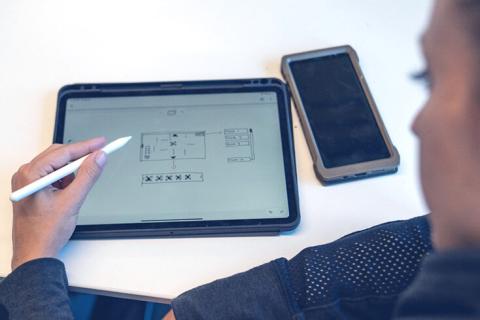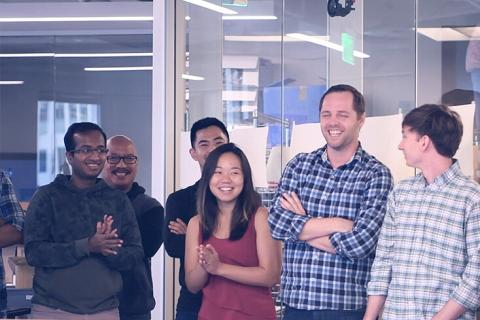[November 8, 2019]
Designing to Optimize User Experience

Tell me about user experience (UX) design. What is it and what is the goal?
User experience design can be thought of as the design of everything that is related to a user’s — or a customer’s — interaction with a company. It includes interactions with the company’s brand, its services, and its products. It covers not only how products look, but how the user feels when interacting with them. Because of that, user experience design is a broad field that spans many different design areas — from website design to physical interactions with a product.
At Shield AI, our user experience team is focused on Human Robot Interaction. We consider what happens when a human user and our robot interact. Our designs are intended to tailor the interactions between our product and our customer to optimize the experience, allowing the user and the robot to seamlessly work together to accomplish the mission at hand.
What types of projects are you typically involved in?
I focus primarily on the user interface (UI) and usability of our products, ensuring that user interactions are effective, efficient and satisfying. I work on many different kinds of projects, from the design of our mobile and web applications to the overall Nova experience and brand.
What makes UI/UX design interesting?
Something that makes this type of work interesting is the collaborative, problem-solving nature of it. In order to produce truly excellent user experiences, your design must consider many different points of view. And to execute on that design, you must rely upon a team of individuals with different skills and expertise.
At Shield AI, the team which focuses on UI/UX is the Human Robot Interaction (HRI) team. We frequently collaborate with other groups within the organization. So I get to work with not only exceptional designers, but also marketers and engineers and product managers, all teaming up to provide the best solutions to our users. It’s always really fun to take on a design challenge and team up with really talented people to iterate and think through potential solutions.
For instance, part of my job includes designing Shield AI’s mobile app. It’s genuinely fun for us to collaborate and solve how to translate a new mobile feature into what it should look like on a tiny screen to best serve our customers. It requires a lot of rethinking and restructuring to figure out how to fit all the pieces while making sure the app looks appealing and operates intuitively. We will spend hours together in conference rooms white-boarding ideas and iterating on them, throwing out different suggestions and trying to work out all of the different possible workflows and steps and edge cases.
You mentioned “edge cases”, what are those?
Edge cases refer to the outer bounds of what a user might be trying to do.
In UI/UX design there is usually a standard workflow you would want the user to apply to get from one place on the interface to another. Occasionally there will be something that a user will want to do that’s slightly different — or there might be something that the user will want to do that might interfere with another interaction. So when we are brainstorming all the possible workflows we have to think through those cases and make sure that all of the interactions are following a design system.
What makes UX design challenging?
A common challenge of UX design is that in many cases, there is not sufficient pragmatic user data to drive design choices in the beginning. This occurs because user data can only be collected once you have a prototype or an MVP — a minimal viable product.
In those moments we must rely on something else to guide our designs. We may employ theoretical best practices or design patterns. We might use data from a previous design, or we may follow our intuition of what would make for good design. But it is not until designs are tested that we can confirm whether the choices we made were the best ones.
Testing is a really enjoyable part of the process because you get to witness if the way you imagined something works and whether you hypothesized correctly. We are fortunate at Shield AI to be able to test our designs frequently and on many different users. This matters because each user group is different and has the potential to provide you with different insights.
What is one aspect of UX design that people might not realize?
Empathy plays a key role in UX design. In my opinion, UX design is the most unselfish and unbiased of all design processes, as you are constantly looking at a product from another’s perspective.
What excites you about UX design?
Especially at a company like Shield AI, the possibilities of where UX can expand into are huge. It’s fascinating to consider moving away from the confines of one screen and into virtual and augmented reality.
In our sphere of human robot interaction, there are a lot of possibilities for what UX will look like in the next few years. It’s changing already and there’s a lot of it that we are pretty familiar with — such as how humans interact with phones and computer screens — but there is also a lot that is new. Learning how an individual can team up with an autonomous robot to better complete missions is really exciting and important. I’m also looking forward to designing for swarms and what that experience will be like for our customers.
Your background is in Graphic Design. Why did you transition into UI/UX and what advice would you give to other designers looking to branch out into UX design?
I’ve had a very gradual transition to UX that started really early on in my career. Through my first job I was introduced to books like David Kelley’s The 10 Faces of Innovation and Steve Krug’s Don’t Make Me Think. These books sparked my initial interest in UX. Steve Krug’s book confirmed common sense notions I had on web design, while Kelley’s book introduced me to the idea of looking at design from different perspectives. I remember that while reading his book I found it to be particularly interesting how he would invite people from very different backgrounds — anthropologists, psychologists, designers — to look at a problem and solve it together. Everybody would approach the problem from a different point of view and have different ideas for solutions.
The great thing about UX is that it is broad, approachable and always has something to teach you. I would encourage any graphic designer looking to transition to volunteer and start building up their UX portfolio by redesigning apps and websites. My recommendation would be to start on the more visual design side of UX because that is probably where their skills will translate most directly. I would also suggest reading a great deal, taking on coding classes, and attending industry meetups. Additional books I would recommend to get started in UX include The UX Book by Rex Hartson and Pardha Pyla, Lean UX Jeff Gothleft and Josh Seiden, and Design for Hackers by David Kadavy.









